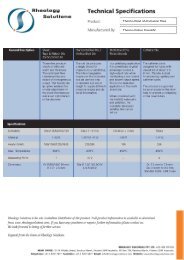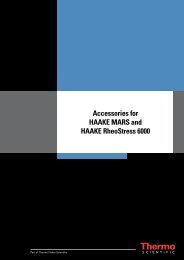Download - Rheology Solutions
Download - Rheology Solutions
Download - Rheology Solutions
You also want an ePaper? Increase the reach of your titles
YUMPU automatically turns print PDFs into web optimized ePapers that Google loves.
• application notes & technical articles<br />
Wet-Shotcrete of Refractory Castables<br />
construction & building<br />
industries<br />
mining industries<br />
In recent years, the refractory<br />
industry has focused much<br />
effort on discovering novel<br />
techniques for castable<br />
installation that combine<br />
high placing rate and low cost<br />
while maintaining final material<br />
properties.<br />
The use of versatile and automated placing<br />
methods such as pumping of self-flowing<br />
castables and shotcrete has been encouraged to<br />
replace the traditional vibration moulding<br />
technique.<br />
Based on these aspects, wet shotcrete is highly<br />
interesting from a technological standpoint,<br />
particularly for the lining of large areas and/or for<br />
the repair of damaged surfaces.<br />
The technique consists of pumping the castable<br />
from the miser to the pipeline nozzle, where<br />
high-pressure compressed air is injected so as to<br />
project the pumped castable onto the surface to<br />
• application notes & technical articles<br />
Rheological Behaviour of Automotive<br />
Paint Systems<br />
surface coatings industries<br />
Modern Characterisation<br />
Methods Show Good<br />
Correlations to Observable<br />
Effects<br />
biennial 07-08<br />
be covered. This promotes a spray flow that<br />
ensures a high installation rate and the formation<br />
of a thick layer.<br />
The difficulties involved in the shotcrete technique<br />
relate mainly to the bonding of the material on the<br />
area to be lined. The primary condition for a<br />
successful operation is that the projected material<br />
does not flow over the back lining refractory<br />
surface, and this requires a sudden loss of the<br />
castable’s fluidity. Traditionally, this effect is<br />
achieved by the controlled use of cement settling<br />
accelerators, which are also injected into the<br />
nozzle.<br />
Although they ensure the material’s cohesion,<br />
conventional accelerators such as sodium silicate<br />
and aluminium sulfate usually deteriorate the<br />
mechanical properties of castables at high<br />
temperatures. Therefore, proposals have been<br />
made for novel additives based on distinct<br />
concepts to promote the rapid reduction of<br />
castable fluidity.<br />
In most bases, material waste is generated during<br />
shotcrete application due to the so-called rebound<br />
effect. This wastage occurs when a portion of the<br />
sprayed castables, which may amount to as much<br />
as 30%, fails to adhere to the applied surface. The<br />
rebound effect, which is also enhanced by the use<br />
of accelerators, can be minimised by selecting<br />
additives that simultaneously impart adhesive and<br />
In this paper the most important measuring<br />
methods for studying the rheological behaviour of<br />
modern paint systems (oscillation tests,<br />
determination of low yield points) are described.<br />
These methods were at first used to describe the<br />
rheological/physical properties of model<br />
polyurethane micro gels. The measured values for<br />
storage modulus, phase shift and yield point in<br />
waterborne Pearle scent/coloured pigment<br />
systems were compared with flop-index values.<br />
The results show good correlations between the<br />
plastic characteristics to the castable, resulting in<br />
homogeneous and cohesive linings, even when<br />
successive layers are applied<br />
In addition to the intrinsically complex pumping<br />
operation, wet-shotcrete applications must also<br />
take into account: (a) an abrupt increase in the<br />
castable shearing rate and the injection of<br />
additives, controlled by the air rate supplied in the<br />
nozzle, and (b) the material’s adhesion and<br />
consolidation on the surface.<br />
The conventional testing techniques, however do<br />
not properly evaluate shotcrete castables, given<br />
the rheological behaviour of these castables under<br />
similar shearing conditions during their installation<br />
is not analysed. The traditional approaches focus<br />
mainly on the influence of additives on the<br />
castable’s consistency (fluidity measurements) and<br />
on post-setting properties.<br />
The main objective of the present study was to<br />
develop a novel shotcrete characterisation<br />
technique based on castable rheometry that<br />
simulates the material’s application. Commercial<br />
wet-shotcrete additives and other compounds with<br />
a high potential for this application were also<br />
evaluated using the new testing procedure.<br />
A complete copy of this article is available on<br />
request by quoting Rf-290802-BR-02.<br />
observable effect and the rheological parameters<br />
of the liquid paint.<br />
Also measurements of powder and electrode<br />
position coatings and clear coats with the<br />
oscillation technique to determine the viscositytemperature<br />
behaviour correlate well with<br />
technical properties of the final films.<br />
A complete copy of this article is available on<br />
request by quoting Rheo008TP.<br />
18 www.rheologysolutions.com










